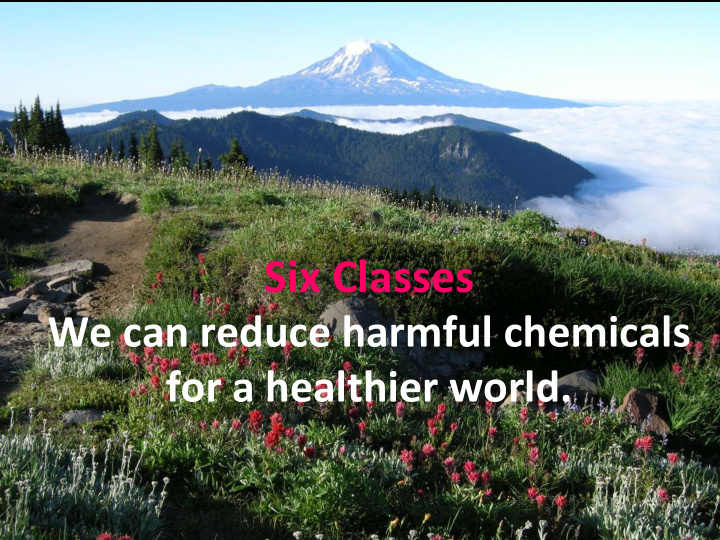



¡ Six ¡Classes ¡ ¡ We ¡can ¡reduce ¡harmful ¡chemicals ¡ for ¡a ¡healthier ¡world. ¡ ¡ ¡
Periodic ¡table ¡of ¡elements ¡ Halogens ¡ 2 ¡
Six ¡classes ¡ 9 ¡ F ¡ 1. Fluorinated ¡chemicals ¡ ¡ stain ¡and ¡water ¡repellants ¡ 17 ¡ Cl ¡ 2. Chlorinated ¡anAmicrobials ¡ ¡ triclosan ¡and ¡triclocarban ¡ 35 ¡ Br ¡ 3. Flame ¡retardants ¡ ¡ brominated, ¡chlorinated, ¡phosphate ¡ 4. Endocrine ¡disrupAng ¡plasAcizers ¡ ¡ BPA, ¡phthalates, ¡etc. ¡ 5. Some ¡solvents ¡ ¡ benzene, ¡methylene ¡chloride, ¡xylene, ¡etc. ¡ ¡ 6. Some ¡heavy ¡metals ¡ ¡ lead, ¡mercury, ¡chromium, ¡cadmium, ¡ arsenic, ¡etc. ¡ 3 ¡
Toxics Use Reduction Institute Solvents Six Chemical Classes Webinar Series Liz Harriman Toxics Use Reduction Institute harriman@turi.org 978-934-3387 October 2013
Solvents – basic functions • Dissolve or disperse materials • Carrier solvents • Cleaning and stripping • Mixing medium 5
Hydrocarbon Solvents • Aliphatic organic • Paints, coatings, solvents thinners – Petroleum distillates, mineral T I N P A spirits, hexane E R N N H I T • adhesives, printing • Aromatic organic inks solvents – Toluene, xylene, benzene 6
Chlorinated Solvents • Methylene chloride • Paint strippers (dichloromethane) Credit: Making it mine blogspot • Dry cleaning • perchloroethylene (perc) 7
Oxygenated Solvents • Examples: • Nail polish and polish • ethyl acetate remover • acetone • glycol ethers • Janitorial cleaners, personal care products • alcohols 8
Volatile Methyl Siloxanes: cyclosiloxanes • Examples: • Dry cleaning • D5 cyclic siloxane • D4 and D5 • Cosmetics, hair conditioners, cyclic siloxanes personal care products (cyclomethicone, cyclosiloxanes) 9
Water Nature’s original solvent 10
Human Health Concerns Broad, diverse category with various concerns • Neurotoxicity – most organic solvents • Carcinogenicity – Chlorinated/brominated • Liver and kidney toxicity – many organic solvents • Reproductive toxicity – e.g., ethylene glycol ethers, N methyl pyrrolidone (NMP) • Contact dermatitis, defatting of skin – many organic solvents 11
Other Concerns Broad, diverse category with various concerns • Environmental Concerns – Volatile Organic Compounds (VOCs) contribute to ground level ozone pollution – Potential groundwater contamination from spills – Persistence – siloxanes, chlorinated solvents • Safety Concerns – Flammability – many organic solvents 12
Examples of Exposure • Methylene Chloride paint strippers – Very volatile, high inhalation exposure Credit: Making it mine blogspot – High vapor density – vapor “sinks” – Worker deaths from bathtub refinishing • Cyclosiloxanes – Volatile, inhalation exposure – Used widely in personal care products and found throughout the environment – Health and environmental concerns 13
Siloxanes - Current activity and concerns There’s no such place as “away” • Cyclic Siloxanes – D4, D5, D6 – EPA negotiating exposure monitoring agreement with industry. Risk assessment is planned. – Biomonitoring in California • D5: Canadian Siloxane D5 Board of Review – concluded that although persistent, unlikely to cause environmental effects • D4: Canada requires pollution prevention planning – EU Determination of Persistent, Bioaccumulative and Toxic 14
Solutions? Safer Alternatives • Paints and coatings: water-based products • Paint strippers: dibasic esters • Garment dry cleaning: wet cleaning • Ethylene based glycol ethers: propylene based glycol ethers 15
Take Away Points for Solvents • Diverse set of substances • Many known health, environmental, and safety concerns – Neurotoxicity, flammability, liver and kidney toxicity, respiratory, eye and skin irritants • Some emerging concerns or questions – E.g., cyclosiloxanes • Safer alternatives available • Move forward using Green Chemistry 16
Contact Information: Book recommendation: Liz Harriman Materials Matter Toxics Use Reduction Institute By Dr. Kenneth Geiser UMass Lowell harriman@turi.org 978-934-3387 www.turi.org “The products we purchase and use are assembled from a wide range of naturally occurring and manufactured materials. But too often we create hazards for the ecosystem and human health as we mine, process, distribute, use and dispose of these materials … This book argues that the safest and least costly point at which to avoid environmental damage is when materials are first designed and selected for use … ” 17
Recommend
More recommend